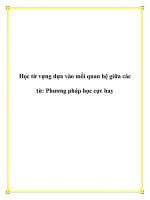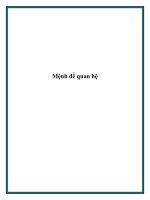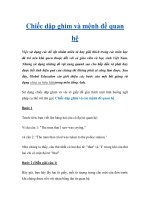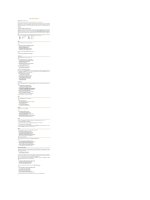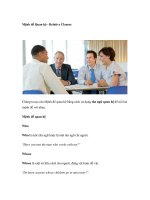Mệnh đề quan hệ tính từ _ Adjective adjectival clause
Bạn đang xem bản rút gọn của tài liệu. Xem và tải ngay bản đầy đủ của tài liệu tại đây (720.62 KB, 19 trang )
CHAPTER X
ADJECTIVES AND ADJECTIVAL
CLAUSE IN ENGLISH LANGUAGE
I. ADJECTIVE
1. Defintion
The adjective is a part of speech expressing quality,
quantity, size, clour, characteristics
The main fuction of an adjective is as an attribute, a
predicative or complement.
Eg:
She is a clever girl
The sky is clear and blue
My cake has sixteen candles
He is tall
2. Classification of adjective
On the ground of their meaning and grammatical
characteristics, adjectives can be classified as:
1, The demonstrative adjectives: used to demonstrate things,
objects, people and phenomena
Eg: This chair is broken
That car is expensive
These clothes are wet
2. The interrogative adjective used to form question to
distinguish things, people, object
Eg: What books are you reading?
What’s your answer?
3. The possessive adjectives: express the possession
Eg: That is my chair
I borrowed her cat
4. The quantitative adjectives: denote the quanlity
Eg: He has many cherries
I ate some roasted chicken
On the ground of their complexity of form and structure, adjectives
can be classified as:
1. The short adjectives: have just one or two syllables
Eg: short, long, cold, blue, smart, happy, ect......
2. The long adjectives:
Eg: interesting, comfortable, expensive, beautiful, careful, ect...
3. The special adjectives: have their own form
Eg: good – better – best
, many/much – more – the most
bad – worse - wost
3. Adjective formation
1. The derived adjectives: formed by adding affixes
The prefixes can be added to adjectives: “dis-, h-,
im-, ir-, un-, anti-, ect...
Eg: unclean, illegal, impossible, inactive...
The suffixes can be added to noun: “-full, -less, -ly, y, -en, -el, -ic, ect...
Eg: careful, careless, windy, friendly, historical, ect...
The suffixes can be added to verbs: “-able, -ible, -ive,
-ing, -en,...
Eg: boring, drinkable, supportive, broken, interested,
ect....
2. The compound adjectives
1. N+adj
Eg: tax free, waterproof, trouble free, world
famous
2. N+ past participle
Eg: middle-age, child-wanted, home-made
3. Adj+ Adj
Eg: big-blue, fat-free, dark blue, light-brown
4. Adj+N
Eg: long-distance, last-minute, cross-eye
5. Adj+N+ed
Eg: narrow-minded, high-spirited, warm
hearted
6. Adj+ present
participle
Eg: good-looking, long-lasting, slow-moving
7. Adj+ past participle
Eg: new-built, old-fashioned, short-haired
8. Adv+present
participle
Eg: never-ending, forward-thinking, far-seeing,
hard-wearing
9. N+ present participle
Eg: time-saving, record-breaking, timeconsuming
10. Adv+ past participle
Eg: Well- behaved, well-educated, well done
The negative form of the above structure
Not so......Adj.....As
Eg: He is not as smart as his brother.
She is not as beautiful as her older sister.
2. The comparative degree of adjective: used to express the
differences or the dissimilarity
There are 2 different kinds
2.1: The short adjects: Adding –er to the positive form of the
adjective.
Short adj+ er+ than
Eg: My essay is longer than yours.
She is smarter than me
3. The superlative degree of adjectives: used to express
what thing or person has the most of a particular quality
within a group or of its kind
3.1: The short adjectives:
(THE) short adj + est
Eg: The biggest table in the room.
She is the smartest girl in the class
3.2: The long adjectives:
(THE) most/least + long
adj
Eg: This is the most beautiful dress I have ever
seen.
She is the least worried about the game.
5. Adjective functions
Are mainly used with 2 functions
1. As attribute: used to come before nouns in the NP
Eg: a nice girl, an old house
a rich businessman
2. As complement: used after the link verbs or the ‘be’
Eg: She is nice.
He looked upset
NOTE:
Adjectives beginning with “A” such as: ( afraid, afloat, alive,
asleep,ect,) are used predicately
Many adjective are used like nouns
Eg: a native, two natives
The rich, the poor, the young
6. The order of adjectives in the
sentences
Quality
size
Age
Shape
colour
materi
al
origin
partici
ple
Eg: A lovely large antique round black Spanish wooden mixing
bowl
II.ADJECTIVE CLAUSE
1. DEFINTION
An adjective clause is a dependent clause that
contains a subject and verb
As an adjective, modifies a noun or pronoun
An adjective clause begin with words such
as that, when, where, who, whom, whose, which,
and why.
2. Classification of adjective
clause
There are 7 types of adjective clause
1. Who
People (subject)
Eg: She is the teacher who helped
me with my math problems.
2. Whom
People (object)
Eg: My sister is the people to whom
I am closest.
3. Whose
People/things
(possessive)
Eg: I have a friend whose daughter
lives in China
4. Which
Things
Eg: Pizza, which most people love,
is not very healthy.
5. That
People/thing
Eg: The books that were borrowed
from class must be returned.
6. Where
Place (adj)
Eg: This is the park where we can
walk the dogs.
7. when
Time (adv)
Eg: Monday is the day when I have
my doctor’s appointment.
2. Based on function of adjective clauses
There are 2 types:
a, Definite clause
Eg: The used car which my dad bought last week broke down
yesterday.
The man who is standing there is a teacher
b. Infinite clause
Eg:The used car, which my dad bought last week, broke down
yesterday.
The man, who is standing there, is a teacher
III. REDUCED ADJECTIVE
CLAUSES
1. Defintion
The reduced adjective clause becomes a phrase, which
does not have a subject.
A phrase does not have a subject and a verb.
2. Classification of reduced adjective clause?
There are 5 types of reduced adjective clause:
1. Active voice
Eg: The girl who attends my school lives at the end
of the street.
The girl attending my school lives at the end of the
street.
Eg: The dog that is lying on the floor won't get up.
The dog lying on the floor won't get up.
2. Passive voice
Eg: The boy who was pleased by his grades went out
with his friends to celebrate.
The boy, pleased by his grades, went out with his
friends to celebrate.
Eg: I like ice-cream that is made in Japan
I like ice-cream made in Japan
3. S + to be +
adj
Eg:The house, which was beautiful, was sold
The beautiful house was sold
4. S + to be + N
Eg: Her name, which is Emmy, contains easy sounds
to pronounce
Her name, Emmy, contains easy sounds to
pronounce
5. S + to be +
prepositional
phrase
Eg: Did you see the book that is on the table?
Did you see the book on the table?
IV. OMISSION OF THE RELATIVE
PRONOUN
Can be omitted the relative pronoun from the adjective clause
when it is the object
When the relative pronoun is the subject of the adj clause, it
cannot be omitted
The relative pronoun ( which, that, who, whom) can be ommited
The relative pronoun ( whose, where, whereby) cannot be
ommited
Eg: I will talk to a consultant whom I met at the party.
I will talk to a consultant I met at the party.
The train which she was about to take was late.
The train she was about to take was late
V. PREPOSITIONS THAT COME
BEFORE ADJECTIVE CLAUSE
There are two ways:
1. Formal: the preposition at the BEGINNING of
the adjective clause
Eg: The address to which you sent the package
was wrong!
2. Informal: the preposition at the END of the
adjective clause
Eg: The address which you sent the
package to was wrong!
VI. “THAT”, “WHICH”, “WHO” IN
ADJECTIVE CLAUSE
1. “That” is not allowed to use in the follows
After prepositions
Eg: Derek is the sibling to whom I am closest.
In indefinite adj clause
Eg: Broccoli, which people often leave uneaten, is very
nutritious.
My brother, who claimed to have a limp, sprinted after
the bus.
2. “That” is compulsory
After combined subjects
Eg: The old man and his dog that walk in the park
After superlative:
Eg: This is the most beautiful house that Jack stays at
This is the most hard question that I face in the competition
After words: all, very, only
Eg: You are the only person that can help us.
After words: first, last
Eg: She is the first girl that I fall in love
After words: much, little, some, any, no
Eg: Much of work I did for you that you have never attented.
In the structure “ It+be+that...”
Eg: It was the first time that I hear of it
After interrogative pronouns
Eg: Who is she that you miss

